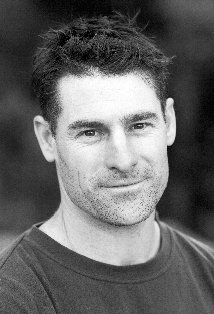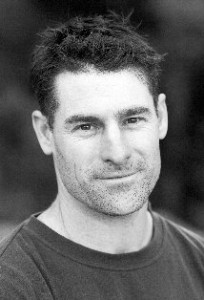
 Archival interview with Keir Beck from the official Matrix website.
Archival interview with Keir Beck from the official Matrix website.
MATRIX: Where are you from originally?
KEIR: I’m from the Gold Coast of Australia, a town called Canungra, which is just inland from Surfers Paradise.
MATRIX: How did you get into the stunt world?
KEIR: It’s something I always wanted to do when I was a kid, and it has taken me about ten years after leaving school to finally get into it. I was a tree surgeon before I started doing stunts; I went down that path for ten years until I woke up one morning and said I should go off and do stunts.
MATRIX: What kind of training did you do in order to prepare yourself?
KEIR: I rode horses and motorbikes as a kid, and I’ve done a lot of rock climbing and, of course, tree climbing, and other sports like mountain biking, archery, and white water paddling.
MATRIX: Here in Australia we’ve noticed that you not only do the stunts, but you actually put up your own rigs. How did you learn that side of it?
KEIR: My rigging history stems from working as an arborist with a tree surgery and rock climbing. That background gave me a good understanding of ropes and how pulley systems work and whatnot.
MATRIX: Tomorrow they are starting to film a scene called the Hel Coat Check, for which you helped set up the amazing rig behind us.
KEIR: We have two systems on this particular tomcat leg, which are four way flying rigs. A four way flying rig means that one part of the flying rig raises you up and down, and the other part travels you right to left (or vice versa). It can also do up and down and travel at the same time as right to left.
Configuring the rig involves lots of pulleys, slings and shackles. Each Dynex cord on the rig is labeled to keep things straight; on track A we’ve got two people flying opposite to each other and up at the same time, and they’re both on the four way flying system which we’ve set up here. Each rig takes about three to four operators, so timing and coordination is important for a good result.
MATRIX: Talk about the process of designing the rig.
KEIR: The first thing is, of course, to look at the storyboards to work out the action, and from that you can work out what sort of rig is required: whether it’s a four way flying system, or a simple lift like the Hong Kong style wire team uses.
If we’re moving someone in a straight line and then pulling them to either side we might need to put a different rig onto the four way flying system, like the one we’re using for Bob [Bowles] who is playing Pinball [Pinball Wizard]; at one point he gets shot and is sent flying at a ninety degree angle to the direction he was traveling in.
MATRIX: What were some of the limitations you ran into on the Hel Coat Check set?
KEIR: The height. It was a matter of trying to accommodate the other departments we work with to make sure our rigs don’t interfere with the lighting or with the Special Effects crew. There were a lot of limitations, but for the size and height that we have here, I think we’ve worked around them quite well; the set is eleven meters wide, three meters high and about eighteen meters long [in yards, approximately 12W x 3.2H x 19.6D].
MATRIX: Is this one of the smallest sets you’ve ever worked on?
KEIR: It is, actually. It has to be one of the smallest sets we’ve ever rigged a flying system in.
MATRIX: How do the stunts and special effects departments coordinate?
KEIR: From the rigging side of things we have to work around them, but they have to work around us as well; the tracks that we use have been placed into the ceiling between the special effects. During the planning stages we said we need a track to go here, and they said okay, we can put our special effects here, here, and here. So we’ve both worked ‘round each other to reach a happy medium, so we can still achieve our action, and they can still achieve their effects with the bullet hits.
MATRIX: The set is built and the rig is built, but how do you know it’s all going to work on the day; how do you test the apparatus?
KEIR: Before the set was built we built a mock set and designed and tested the flying system that we wanted to use. First, we get the materials that we want to use for the system, like the type of rope, which is called Dynex. It’s just four millimeters [approximately quarter of an inch] in diameter, very malleable, and it’s a compatible color to what the interior set is like. We test all this with load cells so that we know it meets our 10:1 safety factor. For example, if a person weighed a hundred kilos then ten to one of that would be a thousand kilos, so we build in that level of safety factor with all of the gear we use.
MATRIX: So, basically, if you weigh a hundred kilos, the apparatus will support a thousand kilos?
KEIR: Yes. That’s the ratio we try to work with whenever we design and build a rig to hang people on. We test everything — from the pulleys to the shackles to the types of cord. Once we’ve tested small bits of the system, we put it together and put a load cell within the system, where we’d hang a person on it to fly, to see what sort of weight we’re pulling and to make sure that we’re not exceeding any limits with the gear. Once we’re happy with that we start rehearsals and work out what we’re capable of doing on the systems.
MATRIX: Are there some new moves on this rig that you’ve never tried before?
KEIR: There are — there are a lot of new moves in the Hel Coat Check scene. As you’re probably aware, there are four main guys in the Coat Check who all have the capability to not only jump from the floor to the ceiling, but who can run around on the ceiling as well. Basically, everything you see playing out on the roof is actually on the roof; there’s no film switched upside down trick photography or anything. It’s all for real.
MATRIX: Why was it decided to do it that way rather than flip the film?
KEIR: That’s probably a question you’d have to ask the Directors, but if I had to guess, I’d say they wanted to see what gravity does for real. That’s firing guns upside down and watching the bullets fall to the floor, and having some of the actors up the right way and other characters upside down so we’d see both elements — up the right way and upside down — in the same shot, with gravity playing its part on clothing and bullets and effects.
MATRIX: So when they’re wearing a coat and walking upside down on the ceiling, the coat will actually be falling back over their head?
KEIR: The coat will fall down, and clothing will drop like it would if you were upside down, but not to the extent where it would mask or hinder action. We’ve also set up systems on the set that we can actually run on single wires with no other cable work involved; it’s all self-motivated by the person on the system. So you can move back and forth, spin around in circles, go upright or back to upside down on a single wire with no one helping you, which is pretty cool.
MATRIX: How did the opportunity come about to work on THE MATRIX sequels?
KEIR: I’ve worked with Glenn [Boswell, Stunt Coordinator, Australia] on his last three films. One was Queen of the Damned, which was shot in Melbourne. Since it was a movie about vampires there was a lot of rigging, and a lot of flying work as well. Then there was Kangaroo Jack, which was mostly cars and camels, no cables. Then Dirty Deeds, an Australian production that we have just finished. And now this, and they’ve all been with Glenn. And I’ve worked on other shows like Crocodile Dundee and a few telemovies.
MATRIX: Thank you, Keir.
Interview by REDPILL
November 2001

Be the first to comment